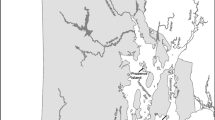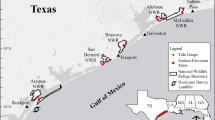Abstract
The Grand Bay estuary is in the north-central Gulf of Mexico and lacks riverine sediment input for marsh elevation maintenance. This study quantified trends in surface elevation change and accretion along an elevation gradient within the estuary. Elevation change rates were compared to short (13.71 mm/yr; 95% CI: -2.38–29.81), medium (6.97 mm/yr; 95% CI: 3.31–10.64), and long-range (3.50 mm/yr; 95% CI: 2.88–4.11) water level rise (WLR) rates for the region. Elevation change rates ranged from 0.54 mm/yr (95% CI: -0.63–1.72) to 5.45 mm/yr (95% CI: 4.27–6.62) and accretion rates ranged from 0.82 mm/yr (95% CI: -0.16–1.80) to 3.89 mm/yr (95% CI: 2.90–4.89) among marsh zones. Only the elevation change rate at a Juncus roemerianus marsh located high in the tidal frame was lower than long- (P < 0.001) and medium-range WLR rates (P < 0.01). The elevation change rate at a lower elevation J. roemerianus marsh was higher than the long-range WLR rate (P < 0.05). No marsh zones had elevation change rates that were significantly different from short-range WLR. These results suggest that J. roemerianus marshes higher in the tidal frame are the most vulnerable to increases in sea level. Lower elevation marshes had higher rates of elevation change driven by sediment accretion and biogenic inputs. Other local research suggests that shoreline erosion is a threat to marsh persistence but provides elevation capital to interior marshes. Marsh migration is a potential solution for marsh persistence in this relatively undeveloped area of the Gulf Coast.





Similar content being viewed by others
Data availability
The elevation and accretion datasets analyzed during the current study are available from National Oceanic and Atmospheric Administration’s Centralized Data Management Office at https://cdmo.baruch.sc.edu/get/landing.cfm. This data and other generated datasets (e.g., water level rise data) can be provided by the corresponding author on reasonable request.
References
Alizad K, Hagen SC, Medeiros SC, Bilskie MV, Morris JT, Balthis L, Buckel CA (2018) Dynamic responses and implications to coastal wetlands and the surrounding regions under sea level rise. PloS ONE 13(10):e0205176
Archer MJ, Pitchford JL, Biber P, Underwood W (2021) Assessing vegetation, nutrient content and soil dynamics along a coastal elevation gradient in a Mississippi Estuary. Estuar Coast. https://doi.org/10.1007/s12237-021-01012-2
Beckett LH, Baldwin AH, Kearney MS (2016) Tidal marshes across a Chesapeake Bay subestuary are not keeping up with sea-level rise. PloS one 11(7):e0159753
Borchert SM, Osland MJ, Enwright NM, Griffith KT (2018) Coastal wetland adaptation to sea level rise: quantifying potential for landward migration and coastal squeeze. J of Appl Ecol 55(6):2876–2887
Bretz F, Hothorn T, Westfall P (2010) Multiple Comparisons Using R. CRC Press, Boca Raton, Florida
Brockwell PJ, Brockwell PJ, Davis RA, Davis RA (2016) Introduction to time series and forecasting. Springer
Byrnes MR, Britsch LD, Berlinghoff JL, Johnson R, Khalil S (2019) Recent subsidence rates for Barataria Basin. La Geo-Mar Lett 39(4):265–278
Cahoon DR, Turner RE (1989) Accretion and canal impacts in a rapidly subsiding wetland II. Feldspar Mark Horiz Tech Estuar 12(4):260–268
Cahoon DR, Lynch JC, Perez BC, Segura B, Holland RD, Stelly C, Stephenson G, Hensel P (2002) High-precision measurements of wetland sediment elevation: II. the rod surface elevation table. J Sediment Res 72:734–739
Cahoon DR, Hensel PF, Spencer T, Reed DJ, McKee KL, Saintilan N (2006) Coastal wetland vulnerability to relative sea-level rise: wetland elevation trends and process controls. In: Verhoeven JT, Beltman B, Bobbink R, Whigham DF (eds) Wetlands and natural resource management. Springer, Berlin, Heidelberg, pp 271–292
Cahoon DR, Lynch JC, Roman CT, Schmit JP, Skidds DE (2018) Evaluating the relationship among wetland vertical development, elevation capital, sea-level rise, and tidal marsh sustainability. Estuar Coast 42(1):1–15
Cahoon DR, Lynch JC, Roman CT, Schmit JP, Skidds DE (2019) Evaluating the relationship among wetland vertical development, elevation capital, sea-level rise, and tidal marsh sustainability. Estuar Coast 42:1–15
Cahoon DR, McKee KL, Morris JT (2021) How plants influence resilience of salt marsh and mangrove wetlands to sea-level rise. Estuar Coast 44:883–898
Cahoon DR, Lynch JC, Knaus RM (1996) Improved cryogenic coring device for sampling wetland soils. J of Sediment Res, Sec A: Sediment Pet Process 66(5):1025–1027
Cherry JA, McKee KL, Grace JB (2009) Elevated CO2 enhances biological contributions to elevation change in coastal wetlands by offsetting stressors associated with sea-level rise. J Ecol 97(1):67–77
Childers DL, Sklar FH, Drake B, Jordan T (1993) Seasonal measurements of sediment elevation in three mid-Atlantic estuaries. J Coast Res 9:986–1003
Dillon KS, Walters SC (2007) Water quality. In Peterson MS, Waggy GL, Woodrey MS (eds) Grand Bay National Estuarine Research Reserve: an ecological characterization. https://grandbaynerr.org/wp-content/uploads/2010/12/Grand-Bay-National-Estuarine-Research-Reserve-Site-Profile-Final-Draft-01Oct2007.pdf, pp 78–95. Accessed 8 March 2020
Eleuterius CK, Criss GA (1991) Point aux Chenes: Past, Present, and Future Perspective of Erosion. Ocean Springs, Mississippi: Physical Oceanography Section Gulf Coast Research Laboratory
Enwright NM, Griffith KT, Osland MJ (2016) Barriers to and opportunities for landward migration of coastal wetlands with sea-level rise. Front Ecol Env 14(6):307–316
Feher LC, Osland MJ, Anderson GH, Vervaeke WC, Krauss KW, Whelan KR, Balentine KM, Tiling-Range G, Smith TJ, Cahoon DR (2020) The long-term effects of hurricanes Wilma and Irma on soil elevation change in Everglades mangrove forests. Ecosystems 23(5):917–931
Ganju NK (2019) Marshes are the new beaches: integrating sediment transport into restoration planning. Estuar Coast 42(4):917–926
Hacker MS (2018) Assessing seed bank contribution to landward expansion of coastal wetland communities and responses to fire. Southern Illinois University at Carbondale, Thesis
Hocking RR (2003) Methods and applications of linear models: regression and the analysis of variance. John Wiley and Sons, New Jersey
Holm S (1979) A simple sequentially rejective multiple test procedure. Scand J Stat 6:65–70
Hothorn T, Bretz F, Westfall P (2008) Simultaneous Inference in General Parametric Models. Biometrical J 50(3):346–363
Howard RJ, From AS, Krauss KW, Andres KD, Cormier N, Allain L, Savarese M (2020) Soil surface elevation dynamics in a mangrove-to-marsh ecotone characterized by vegetation shifts. Hydrobiologia 847(4):1087–1106
Kirwan ML, Temmerman S, Skeehan EE, Guntenspergen GR, Fagherazzi S (2016) Overestimation of marsh vulnerability to sea level rise. Nat Clim Chang 6(3):253–260
Lane RR, Day JW, Day JN (2006) Wetland surface elevation, vertical accretion, and subsidence at three Louisiana estuaries receiving diverted Mississippi River water. Wetlands 26(4):1130–1142
Langley JA, McKee KL, Cahoon DR, Cherry JA, Megonigal JP (2009) Elevated CO2 stimulates marsh elevation gain, counterbalancing sea-level rise. Proc Natl Acad Sci 106(15):6182–6186
Leonard LA, Hine AC, Luther ME (1995) Surficial sediment transport and deposition processes in a Juncus roemerianus marsh, west-central Florida. J Coast Res 11:322–336
McKee KL, Cherry JA (2009) Hurricane Katrina sediment slowed elevation loss in subsiding brackish marshes of the Mississippi River delta. Wetlands 29(1):2–15
Meyer-Arendt KJ, Kramer KA (1991) Deterioration and restoration of the grand Batture Islands Mississippi. Mississippi Geol 11(4):1–5
Mississippi Department of Marine Resources (2008). Mississippi Gulf Coast Historical Aerial Photography Digital Database Development. Coastal Environments, Inc.
Morris JT, Sundareshwar PV, Nietch CT, Kjerfve B, Cahoon DR (2002) Responses of coastal wetlands to rising sea level. Ecology 83(10):2869–2877
National Oceanic and Atmospheric Administration Center for Operational Oceanographic Products and Services (2021) Sea level trends. https://tidesandcurrents.noaa.gov/sltrends/. Accessed 26 May 2021
National Oceanic and Atmospheric Administration (2009) Technical Report NOS CO-OPS 053 – Sea Level Variations of the United States 1854–2006. https://tidesandcurrents.noaa.gov/publications/Tech_rpt_53.pdf. Accessed 19 Feb 2020
Nowacki DJ, Ganju NK (2020) Sediment Dynamics of a Divergent Bay–Marsh Complex. Estuar Coast 44(5):1–15
Office for Coastal Management Partners (2021) NAIP Digital Ortho Photo Image. https://www.fisheries.noaa.gov/inport/item/49508. Accessed 15 November 2021
Osland MJ, Griffith KT, Larriviere JC, Feher LC, Cahoon DR, Enwright NM, Oster DA, Tirpak JM, Woodrey MS, Collini RC, Baustian JJ (2017) Assessing coastal wetland vulnerability to sea-level rise along the northern Gulf of Mexico coast: Gaps and opportunities for developing a coordinated regional sampling network. PloS ONE 12(9):e0183431
Otvos EG (2007) Geologic Framework and Evolutionary History. In Peterson MS, Waggy GL, Woodrey MS (eds) Grand Bay National Estuarine Research Reserve: an ecological characterization. https://grandbaynerr.org/wp-content/uploads/2010/12/Grand-Bay-National-Estuarine-Research-Reserve-Site-Profile-Final-Draft-01Oct2007.pdf, pp 22–46. Accessed 23 August 2020
Passeri DL, Hagen SC, Medeiros SC, Bilskie MV (2015) Impacts of historic morphology and sea level rise on tidal hydrodynamics in a microtidal estuary (Grand Bay, Mississippi). Cont Shelf Res 111:150–158
Pinheiro J, Bates D, DebRoy S, Sarkar D, R Core Team (2019) nlme: Linear and Nonlinear Mixed Effects Models. R package version 3.1–140. https://CRAN.R-project.org/package=nlme. Accessed 18 December, 2020
Program for Local Adaptation to Climate Effects (2021) https://placeslr.org/our-products/gulf-of-mexico-set-inventory/). Accessed Sept 18, 2021
R Core Development Team (2020) R: A language and environment for statistical computing. R Foundation for Statistical Computing, Vienna, Austria. https://www.R-project.org/. Accessed 28 December 2020
Raposa KB, Wasson K, Smith E, Crooks JA, Delgado P, Fernald SH, Ferner MC, Helms A, Hice LA, Mora JW, Puckett B (2016) Assessing tidal marsh resilience to sea-level rise at broad geographic scales with multi-metric indices. Biol Cons 204:263–275
Schenker N, Gentleman JF (2001) On judging the significance of differences by examining the overlap between confidence intervals. Am Stat 55(3):182–186
Smith KE, Terrano JF, Khan NS, Smith CG, Pitchford JL (2021) Lateral shoreline erosion and shore-proximal sediment deposition on a coastal MARSH from seasonal, storm and decadal measurements. Geomorphology 389:107829
Stagg CL, Krauss KW, Cahoon DR, Cormier N, Conner WH, Swarzenski CM (2016) Processes contributing to resilience of coastal wetlands to sea-level rise. Ecosystems 19(8):1445–1459
Terrano JF, Smith KEL, Pitchford J, McIlwain J, Archer M (2019) Shoreline change analysis for the Grand Bay National Estuarine Research Reserve, Mississippi Alabama—1848 to 2017 (ver. 2.0, February 2019): U.S. Geological Survey data release. https://doi.org/10.5066/P9JMA8WK. Accessed 10 October 2020
Turner RE (1990) Landscape development and coastal wetland losses in the northern Gulf of Mexico. Am Zool 30(1):89–105
Turner RE, Baustian JJ, Swenson EM, Spicer JS (2006) Wetland sedimentation from Hurricanes Katrina and Rita. Science 314:449–452
United States Department of Agriculture (1999) Soil Taxonomy: A Basic System of Soil Classification for Making and Interpreting Soil Surveys. United States Department of Agriculture Natural Resources Conservation Service. Agriculture Handbook, Number 436: 871
Wasson K, Woolfolk A, Fresquez C (2013) Ecotones as indicators of changing environmental conditions: rapid migration of salt marsh–upland boundaries. Estuar Coast 36(3):654–664
Wu W, Biber P, Bethel M (2017) Thresholds of sea-level rise rate and sea-level rise acceleration rate in a vulnerable coastal wetland. Ecol Evol 7(24):10890–10903
Wu W, Biber P, Mishra DR, Ghosh S (2020) Sea-level rise thresholds for stability of salt marshes in a riverine versus a marine dominated estuary. Sci Total Env 718:137181
Zuur A, Ieno EN, Walker N, Saveliev AA, Smith GM (2009) Mixed effects models and extensions in ecology with R. Springer Science and Business Media, Germany
Acknowledgements
The authors would like to thank Lindsay Spurrier, Cher Griffin, and Daniel Taylor for assistance with data collection and curation.
Funding
This work was funded in part by an award from the Office for Coastal Management, National Ocean Service, National Oceanic and Atmospheric Administration (award number NA21NOS4200046) and the Mississippi Tidelands Trust Program administered by the Mississippi Department of Marine Resources.
Author information
Authors and Affiliations
Contributions
Study conception and design were performed by JLP, KC, JAC, BTR, and WVU. Material preparation, data collection and analysis were performed by JLP, KC, BTR, JM, and MJA. The first draft of the manuscript was written by JLP, and all authors commented on previous versions of the manuscript. All authors read and approved the final manuscript.
Corresponding author
Ethics declarations
Conflict interest
The authors have no relevant financial or non-financial interests to disclose.
Additional information
Publisher's Note
Springer Nature remains neutral with regard to jurisdictional claims in published maps and institutional affiliations.
Rights and permissions
About this article
Cite this article
Pitchford, J.L., Cressman, K., Cherry, J.A. et al. Trends in surface elevation and accretion in a retrograding delta in coastal Mississippi, USA from 2012–2016. Wetlands Ecol Manage 30, 461–475 (2022). https://doi.org/10.1007/s11273-022-09871-7
Received:
Accepted:
Published:
Issue Date:
DOI: https://doi.org/10.1007/s11273-022-09871-7




